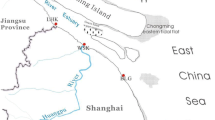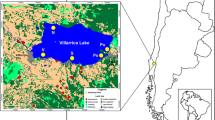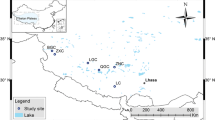Abstract
Volatile organic compounds (VOCs) are important environmental factors because they supply nutrients for microbial cells and mediate intercellular interactions. However, few studies have focused on the effects of VOCs on prokaryotic diversity and community composition. In this study, we examined the relationship between prokaryotic diversity and community composition and the content of VOCs in salt-lake sediments from the Tibet Plateau using amplicon sequencing of the 16S rRNA gene. Results showed that the alpha-diversity indices (Chao1, Shannon, and Simpson) were generally negatively correlated with the content of 36 VOCs (P < 0.05). The prokaryotic communities were significantly driven by multiple VOCs at the lineage-dependent pattern (P < 0.05). Further analysis indicated that VOCs, including 3-methylpyruvate, biuret, isocitric acid, and stearic acid, jointly explained 37.3% of the variations in prokaryotic communities. Supplemental VOCs—pyruvate, biuret, alanine, and aspartic acid—notably decreased the Chao1 and Shannon indices and significantly assembled co-occurrence networks for the bacterial communities in the saline sediments. Together, these results demonstrated that VOCs play a critical role in the regulation of the diversity, compositions, and network structures of prokaryotic communities in saline sediments.






Similar content being viewed by others
References
Appling DR, Rabinowitz JC (1985) Regulation of expression of the ADE3 gene for yeast C1-tetrahydrofolate synthase, a trifunctional enzyme involved in one-carbon metabolism. J Biol Chem 260(2):1248–1256. https://doi.org/10.1016/0165-022X(85)90070-3
Audrain B, Farag MA, Ryu CM, Ghigo JM (2015) Role of bacterial volatile compounds in bacterial biology. FEMS Microbiol Rev 39(2):222–233. https://doi.org/10.1093/femsre/fuu013
Baitsch D, Sandu C, Brandsch R, Igloi GL (2001) Gene cluster on pAO1 of Arthrobacter nicotinovorans involved in degradation of the plant alkaloid nicotine: cloning, purification, and characterization of 2,6-dihydroxypyridine 3-hydroxylase. J Bacteriol 183(18):5262–5267. https://doi.org/10.1128/JB.183.18.5262-5267.2001
Banerjee S, Thrall PH, Bissett A, van der Heijden MGA, Richardson AE (2018) Linking microbial co-occurrences to soil ecological processes across a woodland-grassland ecotone. Ecol Evol 8(16):8217–8230. https://doi.org/10.1002/ece3.4346
Banerjee S, Walder F, Büchi L, Meyer M, Held AY, Gattinger A, Keller T, Charles R, van der Heijden MGA (2019) Agricultural intensification reduces microbial network complexity and the abundance of keystone taxa in roots. ISME J. https://doi.org/10.1038/s41396-019-0383-2
Baran R, Brodie EL, Mayberry-Lewis J, Hummel E, Da Rocha UN, Chakraborty R, Bowen BP, Karaoz U, Cadillo-Quiroz H, Garcia-Pichel F, Northen TR (2015) Exometabolite niche partitioning among sympatric soil bacteria. Nat Commun 6:8289. https://doi.org/10.1038/ncomms9289
Bauer JE, Haddad RI, Des Marais DJ (1991) Method for determining stable isotope ratios of dissolved organic carbon in interstitial and other natural marine waters. Mar Chem 33:335–351. https://doi.org/10.1016/0304-4203(91)90076-9
Berry D, Widder S (2014) Deciphering microbial interactions and detecting keystone species with co-occurrence networks. Front Microbiol 5:1–14. https://doi.org/10.3389/fmicb.2014.00219
Bolger AM, Lohse M, Usadel B (2014) Trimmomatic: a flexible trimmer for illumina sequence data. Bioinformatics 30(15):2114–2120. https://doi.org/10.1093/bioinformatics/btu170
Campbell BJ, Kirchman DL (2013) Bacterial diversity, community structure, and potential growth rates along an estuarine salinity gradient. ISME J 7(1):210–220. https://doi.org/10.1038/ismej.2012.93
Caporaso JG, Kuczynski J, Stombaugh J, Bittinger K, Bushman FD, Costello EK, Fierer N, Peña AG, Goodrich JK, Gordon JI, Huttley GA, Kelley ST, Knights D, Koenig JE, Ley RE, Lozupone CA, McDonald D, Muegge BD, Pirrung M, Reeder J, Sevinsky JR, Turnbaugh PJ, Walters WA, Widmann J, Yatsunenko T, Zaneveld J, Knight R (2010) QIIME allows analysis of high-throughput community sequencing data. Nat Methods 7:335–336. https://doi.org/10.1038/nmeth.f.303
Caporaso JG, Lauber CL, Walters WA, Berg-Lyons D, Lozupone CA, Turnbaugh PJ, Fierer N, Knight R (2011) Global patterns of 16S rRNA diversity at a depth of millions of sequences per sample. Proc Natl Acad Sci USA 108:4516–4522. https://doi.org/10.1073/pnas.1000080107
Delgado-Baquerizo M, Reith F, Dennis PG, Hamonts K, Powell JR, Young A, Singh BK, Bissett A (2018) Ecological drivers of soil microbial diversity and soil biological networks in the Southern Hemisphere. Ecology 99(3):583–596. https://doi.org/10.1002/ecy.2137
Deng Y, Jiang YH, Yang Y, He Z, Luo F, Zhou J (2012) Molecular ecological network analyses. BMC Bioinform 13:113. https://doi.org/10.1186/1471-2105-13-113
Ding X, Liu K, Lu Y, Gong G (2019) Morphological, transcriptional, and metabolic analyses of osmotic-adapted mechanisms of the halophilic Aspergillus montevidensis ZYD4 under hypersaline conditions. Appl Microbiol Biotechnol 103(9):3829–3846. https://doi.org/10.1007/s00253-019-09705-2
Dorador C, Fink P, Hengst M, Icaza G, Villalobos AS, Vejar D, Meneses D, Zadjelovic V, Burmann L, Moelzner J, Harrod C (2018) Microbial community composition and trophic role along a marked salinity gradient in Laguna Puilar, Salar de Atacama Chile. Antonie Van Leeuwenhoek 111(8):1361–1374. https://doi.org/10.1007/s10482-018-1091-z
Edgar RC, Haas BJ, Clemente JC, Quince C, Knight R (2011) UCHIME improves sensitivity and speed of chimera detection. Bioinformatics 27:2194–2200. https://doi.org/10.1093/bioinformatics/btr381
Effmert U, Kalderas J, Warnke R, Piechulla B (2012) Volatile mediated interactions between bacteria and fungi in the soil. J Chem Ecol 38:665–703. https://doi.org/10.1007/s10886-012-0135-5
Hol WH, Garbeva P, Hordijk C, Hundscheid PJ, Gunnewiek PJ, Van Agtmaal M, Kuramae EE, De Boer W (2015) Non-random species loss in bacterial communities reduces antifungal volatile production. Ecology 96(8):2042–2048. https://doi.org/10.1890/14-2359.1
Horton DJ, Theis KR, Uzarski DG, Learman DR (2019) Microbial community structure and microbial networks correspond to nutrient gradients within coastal wetlands of the Laurentian Great Lakes. FEMS Microbiol Ecol 95(4):fizz033. https://doi.org/10.1093/femsec/fiz033
Huang L, Wang Q, Jiang L, Zhou P, Quan X, Logan BE (2015) Adaptively evolving bacterial communities for complete and selective reduction of Cr(VI), Cu(II), and Cd(II) in biocathode bioelectrochemical systems. Environ Sci Technol 49:9914–9924. https://doi.org/10.1021/acs.est.5b00191
Hung CW, Martínez-Márquez JY, Javed FT, Duncan MC (2018) A simple and inexpensive quantitative technique for determining chemical sensitivity in Saccharomyces cerevisiae. Sci Rep 8(1):11919. https://doi.org/10.1038/s41598-018-30305-z
Isaji Y, Kawahata H, Ogawa NO, Kuroda J, Yoshimura T, Jiménez-Espejo FJ, Makabe A, Shibuya T, Lugli S, Santulli A, Manzi V, Roveri M, Ohkouchi N (2019) Efficient recycling of nutrients in modern and past hypersaline environments. Sci Rep 9(1):3718. https://doi.org/10.1038/s41598-019-40174-9
Jiang H, Dong H, Yu B, Liu X, Li Y, Ji S, Zhang CL (2007) Microbial response to salinity change in lake Chaka, a hypersaline lake on Tibetan plateau. Environ Microbiol 9(10):2603–2621. https://doi.org/10.1111/j.1462-2920.2007.01377.x
Jubie S, Ramesh PN, Dhanabal P, Kalirajan R, Muruganantham N, Antony AS (2012) Synthesis, antidepressant and antimicrobial activities of some novel stearic acid analogues. Eur J Med Chem 54:931–935. https://doi.org/10.1016/j.ejmech.2012.06.025
Junker RR, Tholl D (2013) Volatile organic compound mediated interactions at the plant-microbe interface. J Chem Ecol 39(7):810–825. https://doi.org/10.1007/s10886-013-0325-9
Kai M, Haustein M, Molina F, Petri A, Scholz B, Piechulla B (2009) Bacterial volatiles and their action potential. Appl Microbiol Biotechnol 81(6):1001–1012. https://doi.org/10.1007/s00253-008-1760-3
Khan N, Bano A, Rahman MA, Rathinasabapathi B, Babar MA (2019) UPLC-HRMS-based untargeted metabolic profiling reveals changes in chickpea (Cicer arietinum) metabolome following long-term drought stress. Plant Cell Environ 42(1):115–132. https://doi.org/10.1111/pce.13195
Kind T, Wohlgemuth G, Lee DY, Lu Y, Palazoglu M, Shahbaz S, Fiehn O (2009) FiehnLib: mass spectral and retention index libraries for metabolomics based on quadrupole and time-of-flight gas chromatography/mass spectrometry. Anal Chem 81(24):10038–10048. https://doi.org/10.1021/ac9019522
Kormas KA, Pachiadaki MG, Karayanni H, Leadbetter ER, Bernhard JM, Edgcomb VP (2015) Inter-comparison of the potentially active prokaryotic communities in the halocline sediments of Mediterranean deep-sea hypersaline basins. Extremophiles 19(5):949–960. https://doi.org/10.1007/s00792-015-0770-1
León-Zayas R, Peoples L, Biddle JF, Podell S, Novotny M, Cameron J, Lasken RS, Bartlett DH (2017) The metabolic potential of the single cell genomes obtained from the Challenger Deep, Mariana Trench within the candidate superphylum Parcubacteria (OD1). Environ Microbiol 19(7):2769–2784. https://doi.org/10.1111/1462-2920.13789
Liang Y, Zhao H, Zhang X, Zhou J, Li G (2014) Contrasting microbial functional genes in two distinct saline-alkali and slightly acidic oil-contaminated sites. Sci Total Environ 487:272–278. https://doi.org/10.1016/j.scitotenv.2014.04.032
Liu K, Ding X, Tang X, Wang J, Li W, Yan Q, Liu Z (2018) Macro and microelements drive diversity and composition of prokaryotic and fungal communities in hypersaline sediments and saline-alkaline soils. Front Microbiol 9:352. https://doi.org/10.3389/fmicb.2018.00352
Lu J, Brigham CJ, Plassmeier JK, Sinskey AJ (2015) Characterization and modification of enzymes in the 2-ketoisovalerate biosynthesis pathway of Ralstonia eutropha H16. Appl Microbiol Biotechnol 99(2):761–774. https://doi.org/10.1007/s00253-014-5965-3
Ma B, Wang H, Dsouza M, Lou J, He Y, Dai Z, Brookes PC, Xu J, Gilbert JA (2016) Geographic patterns of co-occurrence network topological features for soil microbiota at continental scale in eastern China. ISME J 10(8):1891–1901. https://doi.org/10.1038/ismej.2015.261
Mora-Ruiz MDR, Cifuentes A, Font-Verdera F, Pérez-Fernández C, Farias ME, González B, Orfila A, Rosselló-Móra R (2018) Biogeographical patterns of bacterial and archaeal communities from distant hypersaline environments. Syst Appl Microbiol 41(2):139–150. https://doi.org/10.1016/j.syapm.2017.10.006
Nelson WC, Stegen JC (2015) The reduced genomes of Parcubacteria (OD1) contain signatures of a symbiotic lifestyle. Front Microbiol 6:713. https://doi.org/10.3389/fmicb.2015.00713
Newman MEJ (2006) Modularity and community structure in networks. Proc Natl Acad Sci USA 103:8577–8582. https://doi.org/10.1073/pnas.0601602103
Nunoura T, Nishizawa M, Kikuchi T, Tsubouchi T, Hirai M, Koide O, Miyazaki J, Hirayama H, Koba K, Takai K (2013) Molecular biological and isotopic biogeochemical prognoses of the nitrification-driven dynamic microbial nitrogen cycle in hadopelagic sediments. Environ Microbiol 15:3087–3107. https://doi.org/10.1111/1462-2920.12152
Oren A (2013) Life at high salt concentrations. In: Rosenberg E (ed) The prokaryotes–prokaryotic communities and ecophysiology (4th edition) Springer-Verlag, Berlin, Heidelberg, pp. 421–440.
Podell S, Emerson JB, Jones CM, Ugalde JA, Welch S, Heidelberg KB et al (2014) Seasonal fluctuations in ionic concentrations drive microbial succession in a hypersaline lake community. ISME J 8:979–990. https://doi.org/10.1038/ismej.2013.221
Quast C, Pruesse E, Yilmaz P, Gerken J, Schweer T, Yarza P, Peplies J, Glöckner FO (2013) The SILVA ribosomal RNA gene database project: improved data processing and web-based tools. Nucleic Acids Res 41:590–596. https://doi.org/10.1093/nar/gks1219
Raza W, Wang J, Wu Y, Ling N, Wei Z, Huang Q, Shen Q (2016) Effects of volatile organic compounds produced by Bacillus amyloliquefaciens on the growth and virulence traits of tomato bacterial wilt pathogen Ralstonia solanacearum. Appl Microbiol Biotechnol 100(17):7639–7650. https://doi.org/10.1007/s00253-016-7584-7
Savio D, Stadler P, Reischer GH, Demeter K, Linke RB, Blaschke AP, Mach RL, Kirschner AKT, Stadler H, Farnleitner AH (2019) Spring water of an alpine karst aquifer is dominated by a taxonomically stable but discharge-responsive bacterial community. Front Microbiol 10:28. https://doi.org/10.3389/fmicb.2019.00028
Schmidt R, Cordovez V, de Boer W, Raaijmakers J, Garbeva P (2015) Volatile affairs in microbial interactions. ISME J 9(11):2329–2335. https://doi.org/10.1038/ismej.2015.42
Schulz-Bohm K, Geisen S, Wubs ER, Song C, de Boer W, Garbeva P (2017) The prey's scent-volatile organic compound mediated interactions between soil bacteria and their protist predators. ISME J 11(3):817–820. https://doi.org/10.1038/ismej.2016.144
Schwab AP, Zhu DS, Banks MK (2008) Influence of organic acids on the transport of heavy metals in soil. Chemosphere 72(6):986–994. https://doi.org/10.1016/j.chemosphere.2008.02.047
Sirisena KA, Ramirez S, Steele A, Glamoclija M (2018) Microbial diversity of hypersaline sediments from Lake Lucero Playa in white sands national monument, New Mexico, USA. Microb Ecol 76(2):404–418. https://doi.org/10.1007/s00248-018-1142-z
Smoot ME, Ono K, Ruscheinski J, Wang PL, Ideker T (2011) Cytoscape 2.8: new features for data integration and network visualization. Bioinformatics 27:431–432. https://doi.org/10.1093/bioinformatics/btq675
Sorokin DY, Banciu HL, Muyzer G (2015) Functional microbiology of soda lakes. Curr Opin Microbiol 25:88–96. https://doi.org/10.1016/j.mib.2015.05.004
Sun W, Xiao E, Pu Z, Krumins V, Dong Y, Li B, Hu M (2018) Paddy soil microbial communities driven by environment- and microbe-microbe interactions: a case study of elevation-resolved microbial communities in a rice terrace. Sci Total Environ 612:884–893. https://doi.org/10.1016/j.scitotenv.2017.08.275
Swenson TL, Karaoz U, Swenson JM, Bowen BP, Northen TR (2018) Linking soil biology and chemistry in biological soil crust using isolate exometabolomics. Nat Commun 9(1):19. https://doi.org/10.1038/s41467-017-02356-9
Thitiprasert S, Songserm P, Boonkong W, Sooksai S, Kodama K, Thongchul N (2014) Manipulating pyruvate decarboxylase by addition of enzyme regulators during fermentation of Rhizopus oryzae to enhance lactic acid production. Appl Biochem Biotechnol 174(5):1795–1809. https://doi.org/10.1007/s12010-014-1155-0
Thomas G, Diefenbach R, Duggleby RG (1990) Inactivation of pyruvate decarboxylase by 3-hydroxypyruvate. Biochem J 266(1):305–308. https://doi.org/10.1042/bj2660305
Turroni F, Milani C, Duranti S, Mancabelli L, Mangifesta M, Viappiani A, Lugli GA, Ferrario C, Gioiosa L, Ferrarini A, Li J, Palanza P, Delledonne M, van Sinderen D, Ventura M (2016) Deciphering bifidobacterial-mediated metabolic interactions and their impact on gut microbiota by a multi-omics approach. ISME J 10(7):1656–1668. https://doi.org/10.1038/ismej.2015.236
Tyc O, Song C, Dickschat JS, Vos M, Garbeva P (2017) The ecological role of volatile and soluble secondary metabolites produced by soil bacteria. Trends Microbiol 25(4):280–292. https://doi.org/10.1016/j.tim.2016.12.002
Wang Q, Garrity GM, Tiedje JM, Cole JR (2007) Naive Bayesian classifier for rapid assignment of rRNA sequences into the new bacterial taxonomy. Appl Environ Microbiol 73:5261–5267. https://doi.org/10.1128/AEM.00062-07
Wang Y, Sheng HF, He Y, Wu JY, Jiang YX, Tam NF, Zhou HW (2012) Comparison of the levels of bacterial diversity in freshwater, intertidal wetland, and marine sediments by using millions of Illumina tags. Appl Environ Microbiol 78(23):8264–8271. https://doi.org/10.1128/AEM.01821-12
Werner S, Polle A, Brinkmann N (2016) Belowground communication: impacts of volatile organic compounds (VOCs) from soil fungi on other soil-inhabiting organisms. Appl Microbiol Biotechnol 100(20):8651–8665. https://doi.org/10.1007/s00253-016-7792-1
Wu QL, Zwart G, Schauer M, Kamst-van Agterveld MP, Hahn MW (2006) Bacterioplankton community composition along a salinity gradient of sixteen high-mountain lakes located on the Tibetan Plateau. China. Appl Environ Microbiol 72(8):5478–5485. https://doi.org/10.1128/AEM.00767-06
Wu C, Zhang J, Du G, Chen J (2013) Aspartate protects Lactobacillus casei against acid stress. Appl Microbiol Biotechnol 97(9):4083–4093. https://doi.org/10.1007/s00253-012-4647-2
Xiao M, Wu F (2014) A review of environmental characteristics and effects of low-molecular weight organic acids in the surface ecosystem. J Environ Sci 26(5):935–954. https://doi.org/10.1016/S1001-0742(13)60570-7
Xiong J, Liu Y, Lin X, Zhang H, Zeng J, Hou J, Yang Y, Yao T, Knight R, Chu H (2012) Geographic distance and pH drive bacterial distribution in alkaline lake sediments across Tibetan Plateau. Environ Microbiol 14:2457–2466. https://doi.org/10.1111/j.1462-2920.2012.02799.x
Yang J, Jiang H, Wu G, Liu W, Zhang G (2016) Distinct factors shape aquatic and sedimentary microbial community structures in the lakes of western China. Front Microbiol 7:1782. https://doi.org/10.3389/fmicb.2016.01782
Yang J, Jiang H, Liu W, Wang B (2018) Benthic algal community structures and their response to geographic distance and environmental variables in the Qinghai-Tibetan lakes with different salinity. Front Microbiol 9:578. https://doi.org/10.3389/fmicb.2018.00578
Yao Z, Du S, Liang C, Zhao Y, Dini-Andreote F, Wang K, Zhang D (2019) Bacterial community assembly in a typical estuarine marsh with multiple environmental gradients. Appl Environ Microbiol 85(6):e02602–2618. https://doi.org/10.1128/AEM.02602-18
Yuan J, Zhao M, Li R, Huang Q, Rensing C, Raza W, Shen Q (2016) Antibacterial compounds-macrolactin alters the soil bacterial community and abundance of the gene encoding PKS. Front Microbiol 7:1904. https://doi.org/10.3389/fmicb.2016.01904
Yuan J, Zhao M, Li R, Huang Q, Raza W, Rensing C, Shen Q (2017) Microbial volatile compounds alter the soil microbial community. Environ Sci Pollut Res Int 24(28):22485–22493. https://doi.org/10.1007/s11356-017-9839-y
Zhong ZP, Liu Y, Miao LL, Wang F, Chu LM, Wang JL, Liu ZP (2016) Prokaryotic community structure driven by salinity and ionic concentrations in Plateau Lakes of the Tibetan Plateau. Appl Environ Microbiol 82:1846–1858. https://doi.org/10.1128/AEM.03332-15
Zhou J, Deng Y, Luo F, He Z, Yang Y (2011) Phylogenetic molecular ecological network of soil microbial communities in response to elevated CO2. MBio 2(4):e00122–211. https://doi.org/10.1128/mBio.00122-11
Acknowledgements
This work was supported by the National Natural Science Foundation of China (no. 31100017, 31970120), by the Program of Agricultural Scientific and Technological Innovation of Shaanxi Province (2018NY-156), and by the program of Shaanxi University of Science and Technology (2018BJ-58, 2019BJ-47). We are especially grateful to the editor and reviewers for their valuable comments on the manuscript. The manuscript was edited by Lynette Long, Dartmouth College.
Author information
Authors and Affiliations
Corresponding author
Ethics declarations
Conflict of interest
The author declares that there are no conflicts of interest.
Ethical approval
This article does not contain any studies performed with human participants or with animals.
Additional information
Communicated by A. Oren.
Publisher's Note
Springer Nature remains neutral with regard to jurisdictional claims in published maps and institutional affiliations.
Electronic supplementary material
Below is the link to the electronic supplementary material.
Rights and permissions
About this article
Cite this article
Ding, X., Liu, K., Gong, G. et al. Volatile organic compounds in the salt-lake sediments of the Tibet Plateau influence prokaryotic diversity and community assembly. Extremophiles 24, 307–318 (2020). https://doi.org/10.1007/s00792-020-01155-3
Received:
Accepted:
Published:
Issue Date:
DOI: https://doi.org/10.1007/s00792-020-01155-3




